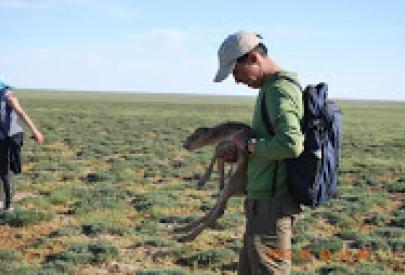Albert Salemgareyev, Altyn Dala Environmental Protection Initiative, Kazakhstan

'To meet saigas was a great piece of luck and a good sign for me!' - A. Salemgareyev
Albert Salemgareyev is Technical Coordinator of the Altyn Dala Environmental Protection Initiative under the Association for the Conservation of Biodiversity of Kazakhstan (ACBK). He started work with this organization as a project assistant in 2007 when he was a student.
The editor of Saiga News interviews Albert Salemgareyev
Albert's research interests embrace informatics, biodiversity, hiking, bird-watching, photography and video filming (which turned into his profession.)
Editor: When did you first become interested in saigas?
Way back in my childhood, I knew about these animals from my parents, neighbours and teachers. I first happened to see saigas when I was a first-year student. It was in 2004 and back then the saiga population was at critically low numbers. Therefore it was a great piece of luck and happiness for me and maybe a good sign!
Editor: When did you start to work in saiga research and conservation?
After my graduation from the Institute, I joined the ACBK team. At that point, a project to research and conserve the Betpak-dala saiga population, the largest saiga population in Kazakhstan, had just been launched. Under this project, a lot of work was conducted including the study of migration routes, improvement of aerial census techniques, expansion of the State Protected Area network and many other things. This work is continuing.
Editor: What is your usual day like?
In my work no day is alike, so it is impossible to give a general description of my day. If we take my usual "field day", then the major part is dedicated to research work: e.g. during aerial censuses you spend your time in the plane where you have to be very focussed to locate saiga groups looking through the window, manage to count them, and take photos to determine their sex-age structure.
And during calving, we carry out transects when we count newborn saigas, determine their sex, and weigh and mark them; to do this we have to walk more than 10km every day. In winter, when rutting begins, we search for rutting aggregations in cars and snow mobiles to see how many males participate.
Work in the office also keeps us from being bored because all the data we have collected need to be processed. Office work is also important for planning and arranging the subsequent field work.
Editor: What are the fundamental problems in your work?
I do not have any particular problems in my work, I love what I do. And if we speak about our work in general, it is worth mentioning a shortage of funding because there are many ideas for research into threatened species but there are not enough resources to implement everything.
Editor: What can be done to remove barriers to your work?
Increase state funding for research and involve the industrial sector in the conservation of biological diversity in Kazakhstan.
Editor: What do you consider the best thing about your work?
One of the best things about my work is that I am doing my favourite work and contributing to a noble cause; it is the highest honour to make a contribution to the conservation and study of the ancient antelope that once walked the earth together with mammoths and woolly rhinoceroses! I consider one more important achievement in our work is the satellite marking of saigas and wolves. We are the first to be doing this in Central Asia, so we may be proud of the work we've done and will gladly share our experience.
Editor: What are the prospects for saiga conservation? What should be the top priority to help the species survive?
Nowadays, the saiga's situation in Kazakhstan is changing for the better, we can observe a more than 30% increase in numbers in two populations: Betpak-dala and Ural; only the Ustyurt population continues to decrease. The State spends enormous funds for protection and study of the saiga. Nonetheless, one of the major problems of today - poaching - is still unsolvable. Today poaching poses the main threat causing decreases in saiga numbers. I think we need to intensify our work on legislation to toughen punishments for poaching.
Editor: What has changed over the time you have been working on research and conservation of endangered species, and what are the current trends?
Unfortunately, I haven't worked in this sphere long enough to be able to make any comparisons. Yet, I have no hesitation in saying that in our Republic, research and conservation of wild animals has changed for the better. This is exemplified by the fact that more and more young people are getting involved in the study of endangered species and take a great interest, with prospects for the future. In addition, many organisations, both national and international, are involved in the conservation of threatened species. If this continues into the future, we will hopefully solve the problem for some endangered species.
